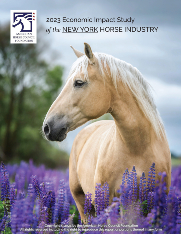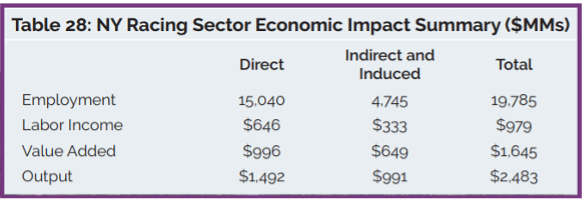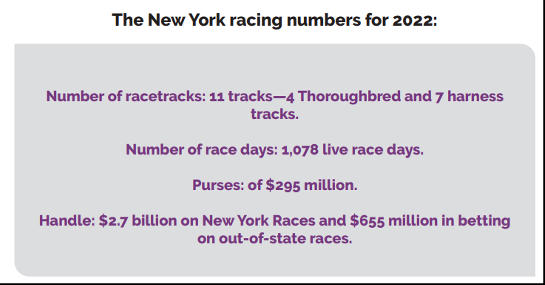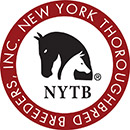 Today results from the American Horse Council (AHC) Economic Impact Study for New York State were released by the equine advocacy group SaddleUpNY!
Today results from the American Horse Council (AHC) Economic Impact Study for New York State were released by the equine advocacy group SaddleUpNY!
“The findings from the American Horse Council’s economic impact study for New York report that the breeding and racing industry is an invaluable asset to our state,” said NYTB President Dr. Scott Ahlschwede, D.V.M. “Our state-bred program has positioned itself as the leading regional program in the nation, and we look forward to continuing to work with our fellow stakeholders to ensure that the additional investment in breeding and racing in New York will result in added revenue for all areas across the state.”

With 11 pari-mutuel racetracks (four Thoroughbred and seven Standardbred), New York hosted 1078 live race days in 2022, with avtotal handle reaching $2.7 billion and purses topping out at $295 million. In addition to race days, New York hosts some of the top sales in North America. The Thoroughbred sales venue at Saratoga’s Fasig Tipton lands in the top 10 for both the Saratoga Sale and the New York Bred Yearling Sale, both of which take place in August. In Middletown, NY, the Goshen Standardbred Yearling Sale in September is among the Top 10 public Standardbred yearling sales in North America.

While most of the highlights of racing come on the track at the sport’s various race meets, the behind-the-scenes work of the people that care for the horses – day and night – is what makes it all possible. That work takes place at home farms, stables and practice tracks across New York, including the rolling fields where young foals first stretch their legs, learning the basics and growing strong to one day become racing prospects. According to Tom Grossman, owner of Blue Chip Farms in Wallkill, NY, “our standardbred nursery boasts an average population of 150 mares and their youngsters with enormous trickle-down economic benefits supporting agricultural entities like hay growers, grain and bedding suppliers, and equipment providers (tractors, trucks, hay balers etc.).” The expanded impact of horse farms is an often unrecognized benefit –including the impact on land preservation and associated capital improvement of the land. Based on the AHC study results, 51% of New York horse owners own or lease a farm, barn or stable, with total acreage estimated at 303,000. And while breeders hope those foals will make it to the track, that doesn’t always happen. Thoroughbred and Standardbred race prospects are highly desired for their ability to transition to new careers, however. New York was an early adopter of mechanisms to support such transitions, with programs such as Take2, TAKE THE LEAD, Thoroughbred Retirement Foundation, Purple Haze Standardbred Adoption, and the Finger Lakes Thoroughbred Adoption Program. In addition, the NY Thoroughbred Breeding and Development Fund has provided well over a million dollars to Thoroughbred aftercare facilities in the state, and annually provides more than $100,000 to facilities that re-train Thoroughbreds or provide sanctuary homes for those that cannot have a useful second career.









